Creative Fun Ways to Teach Simple Present Tense Verbs Rules in English with Examples
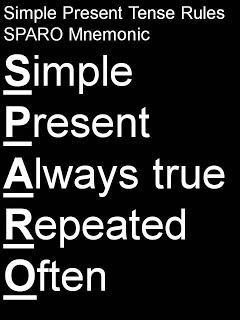
Simple Present Tense Rules
SPARO acronym stands for Simple Present Always true, Repeatedly, Often:-
Use of simple present tense verbs in English is when sentences talk about:- things that are always true
- things that happen repeatedly.
A list of examples of simple present tense verbs in a sentence that talks about things that are always true:- John wears nice clothes. (always)
- The boy thinks you are wonderful (always)
- English grammar books cost a lot (always)
- Terry sings very well (always)
- Our cats never catch mice. (always)
- All those buses go the station (always)
A list of examples of simple present tense verbs in a sentence that talks about things that happens repeatedly:- I work every Sunday (repeated)
- I meet my English teacher every year (repeated)
- I usually walk across this business unit (repeated)
- My business involves calling customers twice a week (repeated)
- I call my manager once a day. (repeated)
- Often I give corporate presentations to amateur sales professionals (repeated)
- I attend business communication skills training workshop twice a week. (repeated)
Another Hint to Remember the Rules of Simple Present Tense Verbs-How Often
Simple present verbs are also used with words that tell how often something is happening. The list of common words can be recalled using another mnemonic-A ONES' OUT: always, once a day, never, every year, sometimes, often, usually, twice a day
Examples of simple present tense verbs that contain A ONES' OUT (indicated in Italic Fonts) words:- My manager always remembers my birthday.
- I never question my boss.
- I visit the corporate office every year.
- I sometimes watch comedy movies.
- My English teacher often helps me in completing grammar exercises.
- I usually organize my office desk on Mondays.
- I send business meeting requests twice a day.
There are several creative and interesting ways to learn and teach English and mnemonics and acronyms are yet another fun way to memorize the rules of English grammar.
You must know list of uncountable nouns, use them during verbal communication in a standard manner. Remembering non count nouns becomes very easy by using this simple mnemonic, FEELING.
Two Important Rules while Using Non Count Nouns
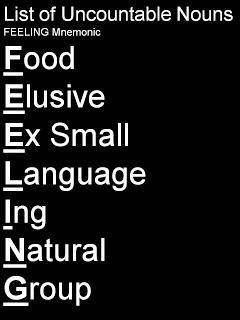
List of Uncountable Nouns Examples
Two important rules in English while using non count nouns are:1. Do not add a "s" at the end of the non count nouns.2. Do not add the word "the" preceding the non count nouns.F Stands for Food Staples
Non Count Noun List: Food staples can be purchased in various forms:
- Bread
- Meat
- Butter
E Stands for Elusive (Abstract) Concepts:
These abstract concepts often have endings like -ness, -ance, -ence, -ity:• Beauty• Ignorance ignorances is non-standard English• Peace
E Stands for Extremely Small Parts
Substances with many small parts:
- Rice
- Sand
- Sugar
L Stands for Languages:
• Arabic• Japanese• Spanish• English
Avoid adding an "s" with these words. Also, avoid adding "the" with these words. The Arabic, the Japanese, the English.
I Stands for -Ing forms (most of them)
Training (many people say "trainings" and "learnings"Â�, which are considered as non-standard English)• Learning (not learnings)• Shopping• Working
N Stands for Natural Substances
Natural substances can change shape, depending on natural laws:
• Steam, water, ice• Smoke, ashes• Oxygen(Avoid saying steams, or waters)
G Stands for Group of things
Group of things that have different sizes and shapes:• Luggage• Furniture(Adding "s", such as luggages or furnitures, are considered non-standard English)
Again, avoid using the word the in the beginning of the sentences with the above list. The rice, the luggage, the steam, the shopping, the bread, the beauty and the training are considered non standard.
List of Uncountable Nouns in English with Examples
List of Great Lakes using Mnemonics
Easy, simple ways to remember and memorize list of great lakes using visual mnemonics:-
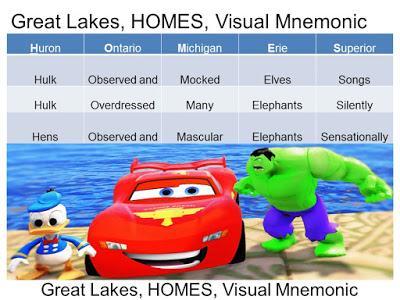
Great Lakes Visual Mnemonic Easy Way to Remember, Memorize.
HuronOntarioMichiganErieSuperior
HulkObserved andMockedElvesSongs
HulkOverdressedManyElephantsSilently
HensObserved andMascularElephantsSensationally
Related Blog Posts
- Mnemonic Devices Examples
- Difference between mnemonic, acrostic, acronym and initials
Other Mnemonics
- Biology Mnemonics
- Chemistry Mnemonics
- Creative Mnemonic Devices
- Customer Service Mnemonics
- English Language Mnemonics
- Geography Mnemonics
- History Mnemonics
- Management Mnemonics
- Physics Mnemonics
- Psychology Mnemonics
- Sales Mnemonics
Mnemonic for Spelling Mnemonic
Easy ways to remember the word mnemonic spelling using mnemonics.
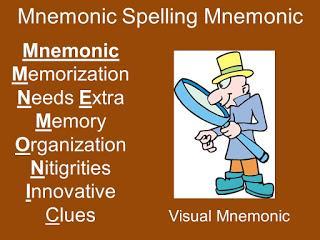
Mnemonic for Spelling Mnemonic
Memorization Needs Extra Memory Organization Nitigrities Innovative Clues
More resources:english.stackexchange
Related Blog Posts
- Mnemonic Devices Examples
- Difference between mnemonic, acrostic, acronym and initials
Other Mnemonics
- Biology Mnemonics
- Chemistry Mnemonics
- Creative Mnemonic Devices
- Customer Service Mnemonics
- English Language Mnemonics
- Geography Mnemonics
- History Mnemonics
- Management Mnemonics
- Physics Mnemonics
- Psychology Mnemonics
- Sales Mnemonics
Press, Accolades and Testimonials of Lifecoachbloggers.blogspot.com
Very happy to share the accolades of my life coaching blog (Updated Nov 2016):
- Existing since: 9/2/2013 (Read my First Post)
- Pageview last Month (Nov 2016): 4000 Plus
- Pageviews all time history: 138,556
- Number of Published Posts: 117
- Several Blog posts of lifecoachbloggers.blogspot.com appear in major online search engines including Google, Yahoo and Bing
- Google Adsense approved blog
- Total Links to my blog: 3,198
I heartily thank God and People who help me to achieve the success
Regards,Sridhar ChandrasekaranLife Coach Blogger
Icebreakers and Energizers for Sales and Customer Service Coaches
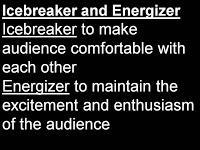
Sales, Customer Service
Icebreakers, Energizers
Icebreaker Vs Energizer
An icebreaker is conducted in order to break the ice among the audience so that they are familiar and comfortable with each other during a training program or a workshop whereas an energizer is conducted into order to bring energy among the audience. Generally, energizers are conducted post lunch in order to ensure the enthusiasm and excitement is ensured during a training session. You can energize the audience either physically or mentally by conducting activities and games.
How to Play Icebreaker and Energizer Games Effectively
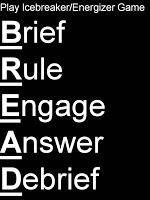
Training Icebreakers
Energizers
Mnemonics are one of the best memorization techniques to recall and remember information. And, BREAD mnemonic is a simple memory trick, which takes only few minutes to memorize, to hint the trainer on how to organize any indoor or outdoor training games and activities.
BREAD mnemonic summarizes how to conduct sales training icebreaker games for facilitators and it stands for:
- Brief
- Rules
- Range
- Rehearse
- Engage
- Extend the time (If required)
- Answers
- Debrief
Icebreaker Introductions Require a Formal Briefing: While briefing, training facilitators tell the name of the game, description of the game, and how to play the game. Briefing helps the participants to understand the nature of the game.
Even a Simple Icebreaker must have Rules: A professional facilitator always writes down the rules of the game clearly with all the dos' and don'ts of a training game or activity so that the confusion is avoided while playing the activity.
An Effective Training Icebreaker will have Range: It is important that training facilitators clearly state the audience how long the game is going to last so that participants could plan their activity.
One of the Ways to Conduct an Effective Training Icebreakers is Rehearse: Some training games are too complicated to explain using mere words. If the trainer wants the game to move smoothly, they should play a trial game in order to clarify all the doubts that might linger in the participants' mind.
Engage the Participants and Conduct Creative Icebreakers: Simply put, play the game. Many professional facilitators also keep reminding the participants about the time lapse while the game is played so that participants know how much time is still left for the activity.
One of the best ways to be creative is to invent an icebreaker. Little thinking skills will open doors to innovative, never before icebreaker activities.
Some Training Icebreakers demand Extension of Time: Experienced corporate facilitators usually keep a buffer time so that the game could be extended in case the game is taking more than the planned schedule.
Training Games and Activities Must Have Answers and Solutions: Facilitators should choose training games for which there is an answer or solution. For instance, if the facilitator is conducting a quiz program, he/she must have the key/answers for the quiz questions. Some facilitators forget to keep the answer key which results in embarrassment in front of the participants.
A Professional Icebreaker will have a Debrief that includes Learning and Examples: Whether it is a facilitation of management skills, technical skills or soft skills, it is always worth spending time on debriefing and, in fact, participants will be glad to hear what they have learnt and will be amazed to know to reflect upon the learning while playing the corporate game. Besides using effective training methods and delivery tools, it is professional of facilitator to organize and structure the training games and activities, keeping the rules in place, planning allotment of time of each task, drafting the participants' learning. BREAD mnemonic is one of the facilitation mnemonics for a well planned training icebreaker activities and Energizers for facilitators.
List of Intrapersonal Characteristics with Examples
Intrapersonal Characteristics can be summed up using 11i mnemonic:- Inner self talk
- Instinctive

Intrapersonal Characteristics Examples
- Intellect
- Intuition
- Influence
- Intentions
- Interpretation
- Inference
- Intensity
- Inflection
- Introspection
Intrapersonal Communication: The communication that happens within yourself is intrapersonal communication. Internal Self Talk, We talk to ourselves with various emotions that include positive or optimistic, pessimistic, empathetic, and neutral tone of voice.
Instinctive:- We are reflexive, either we respond or react to certain life situations. We behave the way we behave because people are influencing us to behave like that. It includes being proactive or reactive with people.
Intellect: Our mind obeys certain logic. It relies on certain proofs and evidences. It includes creative ways to solve problems and finding innovative methods to bring change, managing knowledge and information through memory aids, logic, mnemonics and acronyms to remember daily chores and activities, creative note taking, creative time management, applying intellectual skills to be more effective and efficient.
Intuition: It is reasoning illogically, no proof, no evidences, no reasons and no questions. it could be blind beliefs that are irrational. Few intuitive self belief words include faith, blind acceptance, trust, hope, blind enthusiasm and blind respect.It includes how do you self regulate. Examples includes self motivation, handling personal change and developing a new behavior, habit, etiquette or manners such as developing patience, practicing proactive behavior to name a few.

Intrapersonal Characteristics Examples
Intrapersonal conflict: It includes both your physical and mental conflicts such as your demotivationals, your mood swings, anger, guilt, handling failures, and comprehending your mistakes. Intrapersonal Conflicts can be broadly classified into HEARTS mnemonic. You will have conflicts with Health, Environment around you, Aspirations, Relationships, Things, and the Society.
Intrapersonal Learning Style: Intrapersonal learning style differs from person to person. David Kolb broadly divides learners' styles into 4 categories: We learn, by just hearing to someone (Theorist), when someone shows something (Reflector), when someone makes us do something (Activist) and by burning hands practically experiencing it by ourselves (Pragmatist).
There are several advantages towards intrapersonal development. Your intrapersonal effectiveness will land you into right careers and jobs Your intrapersonal relationship and strength reflects in your interpersonal behavior and communication. You should understand your own self before trying to understand others. You must understand different personalities and the behavior of others either to empathize with them or to persuade them. Your thoughts and understanding about others, the way you interact and your intentions behind the communication is called interpersonal intelligence.
Influence (Personal): Personal influence is bringing personal change in life. Includes being organized, managing time, and tasks, setting personal goals and achieving it.
Influence: We influence people either consciously or sub-consciously. Conscious influence is about persuading, convincing and negotiating with others to prove your opinions and beliefs. Subconscious influence is influencing people without they knowing that you are influencing them. And, Conscious influence is they are aware that you are trying to influence them. You can do that by convincing them through bargaining, persuading, or negotiating. However, you have to get into their strong beliefs, opinions and actions that are prevailing from their birth. In order to be successful, you must first believe in yourself, your thoughts and your actions. Second, you communicate it through interactions and actions.
Subconscious influence: You being influenced without your knowledge. Self-aware influence: You being influenced consciously. So you consciously change something. Here are 11 different types of changes that you experience during self-aware influence: Start a change: you start a change keeping certain goals in mind, Stop a change, Sustain a change, Survive a change, Step-up a change (continuous improvement), Secure a change, Seek a change, Support a change, Seclude away from change, Sense (foresee) a change, Stand-still during a change. When you want to change something, you must have an approach that can be broadly divided into Vision, Mission, Strategy, Competencies and Values.
Sometimes, influences around us is one of the major intrapersonal barriers. So you must be clear of your personal values to break this barrier.
Inner voice:- The communication that is happening within yourself both during normal situations and during conflicts is internal self talk. it is also called intrapersonal communication. The importance of intrapersonal communication is immense especially during intrinsic motivation and intrapersonal conflict resolution.
Intentions: To illustrate intentions, imagine that you are a sales professional who is sells apartments. Intention is your motive, or your purpose behind any act. what is your intention behind selling apartments as a sales professional:
- Sell the apartment to make money
- Sell the apartment so that you meet your monthly sales target
- Help your prospect to get the best deal and value for money
- Suggest the best apartment according to the prospect's needs and desires
Interpretation: Interpretation is the perception, or assumption, you have about yourself, others, and situations. For example, when the prospect objects by saying, "I'm not interested in whatever you are selling", what is your interpretation about the prospect:
- I think the prospect does not have enough money to buy this apartment
- I think the prospect does not have trust in me
- I think the prospect already has an apartment
- I think the prospect needs more information about the deal.
Inference: The difference between interpretation and inference is, interpretation is your perceptions, or assumptions, about yourself and the prospect BEFORE and DURING the conversation, while, inference is the conclusion you draw out of context, about the prospect and the situation. For example, if the prospect buys the apartment after a firm persuasion made by you, you would conclude:- I think I have to persuade every prospect to make a sale
- I think it was luck that this prospect accepted my offer
- I think prospect is quite rich and has the ability to buy two more apartments if I had persuade even harder
- I think the prospect liked the way I persuaded the offer.
Inverse (Boomerang): In certain situations, what you think of others is what you think of yourself. If you expect others not to make mistakes, you expect yourself to be perfect. if you hate people who get angry, perhaps, you will hate yourself if you get angry.
We come across several self conflicting situations in life. It includes mental and physical health, relationship with others, and professional aspirations and goals. It includes how we react or respond to changes.(Intonation)
Intensity: Intensity is the degree of emotion and feeling during an event. For example, how do you feel when you sell an apartment?
- Very excited because you feel contented, satisfied and pleased about the sale and you are happy that your prospect has got the best deal
- Feel OK and move on to the next prospect so that you achieve the target for this month
- It does not mean anything to you because it is part of your job achievements.
How emotionally close you are with the others is intimacy. Self disclosure is one example of intimacy. People's sensitivity level about an idea differs. Something that is sensitive to you may not be sensitive to others. Intensity is the degree emotions and feelings during a life event. For example, how deep you feel when you either win a lottery ticket or lose a job. It determines our emotional sensitivity.
1.1.8 Inflection:
Inflection is the variation of your emotions, feelings and thoughts based on the people and situation. For example: imagine that your confidence dropped when the prospect said, "I'm not interested", how quickly did you change your attitude to optimism, encouraged yourself to give more benefits to the prospect rather than getting discouraged.
And, imagine that you were very happy the moment the prospect accepted your offer. Now, how quickly were you able to retrain--hold down--your excitement and closed the sale in a calm and composed manner.
How quickly you resume yourself (Inflection).Mood swings, and feelings are some examples our emotions. And, how do you feel when there is a conflict or when you make mistakes, or when you face failure in life. Sometimes we are confused why internal conflicts happen. Feeling guilty, handling failures, your thoughts, feelings and opinions about the mistakes that you've made in life are some examples of intrapersonal conflict. Once you identify them it will be easy to resolve them through self motivation skills. You have to identify your personal decision making styles that include perception, ethical, apathetic, rational and legal.
Once you are aware of yourself, your beliefs, your thoughts and your personal values, you can decide whether to cherish your life or would you like to change it through self regulation or just stay where you are right now through self management. So, for self regulation and self management, self awareness skills provide a ground. Above all, you will be able to solve several intrapersonal conflicts in life if you are aware of yourself.
Introspection
To introspect is to find out your own feelings and thoughts. what happens to you when you make a mistake, why do you make mistakes in the first place, how do you feel when you fail to achieve something. when do you get angry and why. How do you handle embarrassment and guilt.
You have acquired certain thoughts, behavior and attitude from your ancestors. This could include, patience, impatience, self confidence, and straightforwardness to name a few. We are what we are because either we have inherited these traits from our ancestors or we have acquired it from people around us. Personality is inborn traits while behavior is how we behave with different personalities we meet. Few example of personality includes our inborn characteristics such as being assertive, aggressive or passive.
There is one constant inner voice that talks to you all through your life, sometimes even in dreams. Have you identified your inner voice. is it positive, pessimistic, empathetic or neutral.
List of Common Life Events
List of common life events can broadly classified into 6Cs:
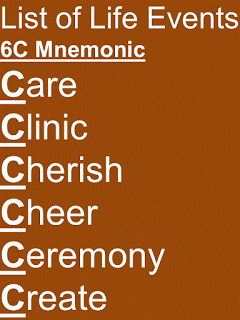
List of Major Life Events with Examples
- Create: Make Money, Make something on your own
- Care: Going to Bank, taking care of money, and other stuff
- Clinic: going to doctor, serving your vehicle
- Cherish: enjoying, partying your/others' achievements, birthdays, wedding anniversery
- Cheer: motivating yourself or others
- Ceremony: Death ceremony for example
Good Conclusion Transition Words
Professional sales training programs should have a good introduction, body and conclusion. sales trainers can use mnemonics, which is one of the most commonly used memory tricks, to remember how to conclude a presentation during corporate trainings, motivational workshops and management skills trainings. SPANER mnemonic acts as a checklist on how to end a presentation effectively.
SPANER stands for:
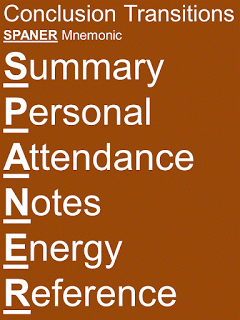
Conclusion Transition Words
1. Summary
2. Personal information
3. Attendance and feedback
4. Notes and materials
5. Energy
6. References
Presentation Summary
Many corporate training last for one full day or sometimes run for a week or two. It is ideal to give a brief summary towards the end of each business management training programs so that participants can recall the entire training program. Here is an example of one of the motivational workshops where a corporate soft skill trainer summarized the topic:"We have almost come to an end of the presentation. Now, anyone who quickly summarizes the 10 most important key points of this corporate management training program will get a small gift"
Personal Information to Keep in Touch
With social networking getting so popular these days, corporate trainers can exchange office address, telephone numbers, email ids, social networking profiles before concluding a presentation. On one hand, exchanging personal information encourages the participants to keep in touch so that any doubts or clarification could be cleared even after a training program; On the other hand, corporate trainers take this opportunity to send newsletters and updates on the topic of discussion.Presentation Feedback and Attendance
Many business firms insist the management trainers to maintain attendance and feedback after every business training programs. Maintaining attendance has two benefits:1. It serves as a record of participation
2. It helps in tracking the learning curve of the participant.
On the other hand, feed back helps in identifying what went well and what needs improvement in training.
Presentation Notes and Materials
It is quite common to end a presentation by distributing notes and materials such as literature, lecture and handouts to the participants so future reference. In many corporate management training programs, the training administrator takes printouts of the notes to ensure that every participant gets one copy.Energetic and Enthusiastic Presentation
Besides good technical skills, a trainer should not only have passion, energy and enthusiasm while conducting a corporate training session but also sustain it till the end of the presentation. Here is one example presentation speech on how to end a presentation with good energy:The trainer says, cheerfully,
"I hope all of you enjoyed the presentation. It has been my pleasure to be part of this great management team and I had both fun and inspiration all through the session. Thanks a lot for your cooperation".
Presentation Reference
Other than corporate management training notes and materials, many trainers take an extra step to suggest good books, cds, dvds, newsletters, journals, websites, and blogs of the related management topic. This helps the participants to broaden their knowledge on the subject.So, this simple mnemonic device, SPANER, can remind any sales trainer on how to close a presentation speech or conclude a presentation.
Presentation Transitions Words Phrases
Good presentation transition is one of the essentials of top seven vital elements of effective presentation skills. Planning, preparing and prioritizing the sales presentation transition is one of the key elements of every good sales presentation. In fact, many sales advisor believe planning prevents poor performance (4P). BAD is yet another acronym that helps salespersons to remember how to structure any presentation based on time factor.BAD Acronym stands for:

Presentation Transition Words and Phrases
- Before
- After
- During
Plan 4Ms before Presenting
4Ms simply remind what to plan before delivering any presentation.4Ms Stands for:
1. Minutes: Minutes include schedule, coffee/tea breaks and the time allotment for each topic of the transition.
2. Materials: Materials include all the stuff required to run a program, which include pen, notes, projector, water bottles etc.
3. Mind: Mind simply reminds the speaker to keep a calm and relaxed attitude before the presentation. Positive self talk such as , "It is going to be an easy show", "I am fine the topic" can improve the intrapersonal skill of the speaker. In fact, speakers work on creative presentation ideas rather than thinking about how the presentation is going to turn out.
4. Manpower: Manpower includes how choosing the right audience, analyzing the group size, sending invites and reminders. Or calling them in advance to confirm the participation
Transition Words and Phrases Examples:
- First
- To begin with
- Let Us start with
- Good Morning
Verbal and Non-verbal Communication During the Presentation
Both verbal and non verbal communication skills are vital during the presentation. Using rapport building statements, transition statements and good tone of speech are some of the elements of verbal communication, while having a good eye contact, friendly smile, right way of using the stage shows excellent non-verbal communication. A good speaker keenly harmonizes his/her visual, auditory, and kinesthetic elements to deliver an effective speech.Transition Words and Phrases:
- We are in the middle of...
- 50 percent of presentation is covered
- Half of this presentation was about....now the rest is going to be...
Handling Questions After the Presentation
Some of the qualities of a good speaker includes closing the presentation with interesting conclusions, answering lingering questions of the audience, and providing resources and learning materials for the participants. Some speakers exchange contact information to send regular newsletters on the topic of discussion. And, many speakers make optimum use of online social networking to keep in touch with participants. Closing the presentation with enthusiasm is as important as beginning the presentation with excitement.Transition Words, Phrases and Sentences:
- Finally...
- Last few lines about...
- Before we end...
